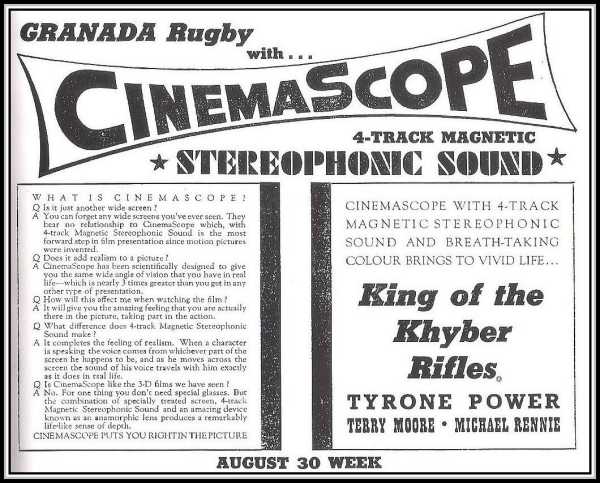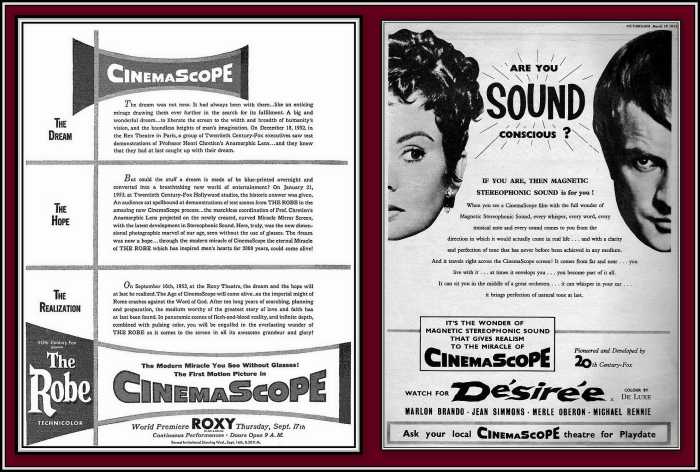| Of the
many cinematic wonders
and processes that were
developed in order to
lure customers back to
the cinema, CinemaScope
was, in my opinion,
the ultimate spectacle
at that time and was able
to capture and project
exactly what I wanted in
film. Tragically, since I
was not to experience Camera
65,
TODD-AO
or Cinerama
until the late 1950s,
I was not able to
appreciate fully what spectacle
in film truly meant.
As a result of this, I
have always believed my
childhood to be deprived!
However, I did experience
CinemaScope and for
this, I am deeply
grateful to Henri
Chretien for his insight
and ability to produce
the first anamorphic
lens, 20th
Century Fox during the
1950s and in
particular Mr. Spyros
Skouras for
arriving in Paris ahead
of the competition,
Bausch & Lomb Inc., and,
to some extent,
Panavision. Although
Mr. Solomon Sheckman had
nothing to do with the
development of the
process, it is thanks to
his insight and ingenuity
that I first saw the
first film produced in
the magnificence of CinemaScope
at the Essoldo on
Bethnal Green Road. For
those of you that do not
know what CinemaScope is,
I recommend a visit to The
American Widescreen
Museum.
Here, the curator, Mr.
Martin Hart, provides
information on all
widescreen formats and
gives a detailed history
of the development and
application of each
process including CinemaScope.
This is one of the
most remarkable and
interesting websites that
I have ever visited and I
recommend it highly to
anyone with even the
slightest interest in
film. It is informative
and, at times, amusing.
This is not a dusty website
filled with technical
details. Rather, the
material is presented in
a manner to maintain the
reader’s interest.
Briefly, CinemaScope
is an anamorphic lens
series that allowed the
projection of film images
to be seen on a wider
screen than was currently
being used prior to 1953.
Anamorphic basically
means a controlled
distortion. Photographing
with an anamorphic lens
allows the squeezing of a
wide image onto a narrow
film. Once the film is
projected through a
similar anamorphic lens,
the image will appear on
a screen in its full
width and without
distortion. Originally, CinemaScope
allowed the width of
the projected image to be
2.66:1, known as
the projected aspect
ratio. Such a projected
aspect ratio means
that the width of the
image on the screen was 2.66
times the height. Up
until then, the projected
aspect ratio of standard
film was 1.37:1 (known
as Academy Format).
With the introduction of CinemaScope
to local cinemas, the
average cinema goer was
introduced, as the
advertisements said, to huge
panoramic views and
the feeling that they
were part of the film
– all without the
aid of special glasses.
Once 20th
Century Fox began
producing its films in CinemaScope,
the company insisted that
the cinemas showing their
films had to adhere to
certain strict standards
and requirements
including equipping all
cinemas with four-track stereophonic
sound. In order to
fit four sound tracks
onto the film required
the projected aspect
ratio to be reduced
to 2.55:1. However,
many cinemas including drive-ins
were unable to offer stereophonic
sound to their
audiences. 20th
Century Fox overcame
this problem by the
addition of a standard
track to the film. As
a result of this
addition, the aspect
ratio was reduced
further to 2.35:1.
For my
part, once the ice cream
sales-ladies left the
auditorium and the lights
dimmed and the curtains
slowly parted to reveal
that giant screen, and
once I heard the sound of
the drum leading into
that breathtaking
introduction, which
heralded A
CinemaScope Picture,
I had no interest in
the finer points of the projected
aspect ratio. Regardless
of the technicalities
that went to make up CinemaScope,
I had come to enjoy
the film that was to loom
large before me on what
was then a giant
widescreen. Hearing
the 20th
Century Fox introduction
was a treat in itself and
a sign to snuggle down in
my seat and be ready,
willing and able to be
transported off to some
mysterious and
magnificent place where I
knew that I would be
totally and utterly
captivated for however
long the film lasted.

Advertisment
for CinemaScope
and 4-Track
Stereophonic Sound prepared
by Granada Cinemas
(click to
enlarge)

(Click on
the pages to enlarge)
I would like to thank Mr.
Brian Hall for his
kindness in allowing his
materials to be
reproduced here.
|